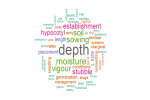Analysis of the impact of nitrogen decision-making systems indicates that yield does not need to be sacrificed to achieve environmental gains
New research measuring the greenhouse gas emissions of various nitrogen (N) input strategies is showing that applying higher than the national average fertiliser rate can not only maximise yields but also minimise negative impacts on the environment.
The research, led by Professor James Hunt and Dr Arjun Pandey at the University of Melbourne’s Dookie Campus in central Victoria, is comparing nitrous oxide (N2O) emissions, yield and the overall greenhouse gas effect of various N decision-making systems.
These include the N bank strategy, the Yield Prophet digital decision-support tool, and N application based on national average (45 to 55kg N/ha) and zero application rates. It shows that when soil carbon storage and N crop uptake are considered along with N2O emissions, the high-input N bank approach has lower emissions intensity than the other systems tested.
Harvest results from 2023 and 2024 showed that yields were higher using N bank application rates rather than the lower national average and zero N fertiliser rates. In these years, N bank yields were also higher than those achieved using Yield Prophet.
“The idea behind the research is to assist grain growers in making more informed and less risky nitrogen decisions,” says Dr Pandey, who is using a static chamber to capture and measure N2O emissions produced by the various systems throughout the season. The research is part of a GRDC-supported RiskWi$e investment.
Risk management factors
Measuring N2O emissions is critical from a risk management perspective, says Dr Pandey.
This is because as Australia moves to achieving net-zero greenhouse gas emissions by 2050 as a signatory to the Paris Agreement, it will be important for farming systems to demonstrate reductions. The research will help growers make informed decisions around fertiliser application to reduce risk around both yields and environmental impact, he says.
“One molecule of nitrous oxide does the same global warming job as 273 molecules of carbon dioxide, and nitrogen fertiliser contributes to these emissions,” Dr Pandey says.
“So it’s important for growers to understand which fertiliser decision has less emissions intensity, rather than just yields.”
Importantly, Dr Pandey says, the research indicates that grain growers will not need to reduce nitrogen inputs and compromise yields to meet international obligations and reduce the emissions footprint.
There is an assumption that applying more nitrogen will immediately contribute to more nitrous oxide emissions, which is true at the outset, but it appears that is not the case when you look at the bigger picture, especially in our dryland grain cropping systems.
The big picture
The Dookie trials, measuring emissions from a range of nitrogen application rates associated with various strategies, are helping to build this bigger, clearer picture of the impact of fertiliser use.
The trials treatments include:
- zero N fertiliser application;
- a national average application rate
of 55kg/ha of N; - N rates to achieve water limited potential yield for Decile 5 and Decile 7-8 seasons using the Yield Prophet tool, which uses historical climatic data, existing soil mineral nutrients and growing season rain forecast at the time of decision-making in its calculations. Based on soil mineral N measured before sowing and predicted growing season rainfall, the Yield Prophet tool prescribed:
- 26kg/ha N in 2023 for both yield probability (decile) levels;
- 14kg/ha and 114kg/ha N in 2024 for Decile 5 and Decile 7-8 seasons;
- the N bank approach. This sets an N target for a location to achieve economic yield in most seasons, regardless of seasonal yield forecasts, by taking soil mineral N into account before sowing. The N bank target set for Dookie was 275kg/ha of N. The amount of fertiliser N is calculated by deducting the existing soil mineral N measured before sowing from the target rate. Therefore, to achieve a total of 275kg/ha of N:
- 135kg/ha N was applied in 2023;
- 172kg/ha N was applied in 2024.
Results from 2023 (Table 1) showed that when emissions alone were measured, the N bank system produced the most nitrous oxide at 1.7kg N/ha. This is more than double the 0.8kg/ha of nitrous oxide produced when national average rates of N were applied. Nitrous oxide emissions were also low using the Yield Prophet approach at both yield target levels (0.3kg and 0.5kg N2O-N/ha) due to the low N input in the systems.
However, when N2O emissions were considered along with soil nitrogen balance and soil organic matter mineralisation, the N bank system led to the lowest level carbon footprint.
If we look at the whole story, the N bank treatment has a close to neutral (-3kg N/ha) ‘partial nitrogen balance’ compared to systems using lower application rates.
Nitrogen balance
Dr Pandey explains the ‘partial nitrogen balance’ – or the amount of N removed in grain production versus what is applied – is important not only for the ongoing soil fertility, but also overall emissions.
The national average N application rate produced a partial N balance of -52kg/ha. The systems applying Yield Prophet had -82kg and -76kg N deficits for the Decile 5 and Decile 7-8 yield targets, respectively. Under the N bank system, that deficit was reduced to -3kg/ha.
This more neutral partial N balance under the N bank system means more nitrogen is retained for future crops, less organic carbon is ‘mined’ from the soil and lower carbon emissions are produced, Dr Pandey says.
“If we mine soil nitrogen (rely on soil N for crop uptake), we are depleting soil organic matter (SOM) which has 12:1 carbon-to-nitrogen ratio and this contributes to carbon dioxide emissions,” he says.
“But if we are maintaining or increasing nitrogen in soil, it is contributing to soil organic matter build-up and sequestering carbon.”
Table 1: Comparison of the effect of different N management systems on wheat yields, N2O emissions, partial N balance, and carbon dioxide equivalent greenhouse gas emissions (CO2eq) in 2023.
Treatment | N rate | N exported in grain (kg/ha) | Partial N balance (kg/ha) | 1Soil C loss (kg/ha) | N2O emissions (kg/ha) | 2CO2-eq GHGs emissions (kg/ha) | 3Carbon footprint (kg CO2-eq/ha) |
|---|---|---|---|---|---|---|---|
Nil | 10 | 77 | -67 | 800 | 0.4 | 100 | 3032 |
National average | 55 | 107 | -52 | 625 | 0.8 | 214 | 2505 |
YP Decile 5 (50%) | 26 | 108 | -82 | 987 | 0.3 | 81 | 3699 |
YP Decile 7-8 (75%) | 26 | 102 | -76 | 908 | 0.5 | 142 | 3471 |
N bank | 135 | 138 | -3 | 35 | 1.7 | 467 | 597 |
1Soil C loss was calculated based on partial N balance, which is directly linked with soil carbon balance. SOM has C:N ratio of 12:1 (Kirkby et al. 2011, 2013), so loss of one unit of N leads to loss of 12 units of C.
2CO2-eq GHGs emissions was calculated based on the global warming potential of N2O which is 273 times higher than CO2 (Forster et al., 2021)
3C foot print (CO2-eq) was calculated by converting soil C loss to CO2 (a unit of C is multiplied by 44/12 to convert to CO2) and adding CO2-e GHGs emissions values from the second last column.
Source: Dr Arjun Pandey and Professor James Hunt, University of Melbourne
Emission equation
An analysis of nitrogen budget and CO2eq greenhouse gas emissions showed the N bank system compared favourably to others. In 2023, the N bank led to a CO2eq footprint of 597kg/ha, whereas the national average N application rate had a 2505kg/ha CO2eq footprint. Yield Prophet N application rates based on Decile 5 produced 3699kg/ha CO2eq, and 3471kg/ha CO2eq was produced with rates based on Decile 7-8. This was more than double the CO2eq footprint of the N bank.
“So even though N bank nitrous oxide emissions were double (other systems), the outcome was the opposite if we take a broader view and look at the maintenance of nitrogen and carbon in the soil,” Dr Pandey says.
He says the results show the importance of looking beyond just one measurement in isolation. “And obviously a reckless application of nitrogen is not good.
But if it is timed well as part of a deliberate, targeted system it is better than applying lower nitrogen or deficient nitrogen.”
Yield benefit
The research also confirmed the significant impact of N rate decisions on yield.
In 2023, wheat yields, determined from quadrats cuts, were greatest in plots using the higher N bank rates, returning an average of 7.1t/ha.
Yield under the national average rate was 5.8t/ha. Yields in Decile 5 and Decile 7-8 in the Yield Prophet system where 6.3t/ha and 5.7t/ha, respectively.
The 2024 growing season results further support these findings, with 8.5t/ha barley yields in the N bank system compared with 6.8t/ha and 8.1t/ha in Decile 5 and Decile 7-8 in the Yield Prophet system and 7.7t/ha using the national average N rate.
In 2024, low emissions were recorded across all N decision-making systems. The N bank system and Decile 7-8 in Yield Prophet led to nitrous oxide emissions of 0.1kg/ha over the growing season, whereas emissions in other systems were negligible.
Dr Pandey says emissions in 2024 reflect the low growing season rainfall.
“Nitrous oxide emissions rely on the nitrogen rate but it is also stimulated by soil moisture, so because it was dry, there were fewer emissions which makes the N bank look even better,” he says
Sustaining crop nutrition
Building an understanding of emissions associated with higher nitrogen inputs is important because research shows the national average N rate (45-55kg/ha) is not enough to sustain yields. Therefore, relying on soil organic matter for a crop’s nutrition requirement is not sustainable.
This is being further tested in several trial sites in Victoria, NSW and South Australia in research led by Professor James Hunt, which is looking into the impact of the N bank approach on yields.
A recently published journal article based on the first five years of data from Curyo in north-west Victoria shows that a carefully chosen N bank target can achieve economic yields in most years without mining soil organic matter.
Long-term modelling at the Dookie site by RiskWi$e national project lead Dr Lindsay Bell further illustrates the impact of applied N on yield and emissions over time.
It shows that when N inputs balance outputs over the long-term, this achieves the lowest overall GHG emissions from the soil while optimising long term grain yield and economic outcomes.
While N2O emissions increase as N application rates increase, once the impact on soil C is included, this compensates. Together with the higher yields over the long-term, this produces the lowest greenhouse gas intensity or emissions per tonne of grain produced.
Dr Pandey says the goal of the emissions research, which will continue through 2025, is to provide data to support informed N application decisions for optimal outcomes for both farming businesses and the environment.
It’s showing that you can apply more nitrogen to achieve higher yields without contributing to global warming.
Terms explained
Greenhouse gases (GHG) contribute to a greenhouse (warming) effect by trapping infrared radiation in the atmosphere. Carbon dioxide (C02), methane, and nitrous oxide (N2O) are common examples.
Global warming potential (GWP) is a measure of how much heat GHG traps in the atmosphere. Calculations are based on how long GHG remain in the atmosphere and infrared absorption intensity.
Carbon dioxide equivalent (CO2eq) is a measure of different gases’ GWP compared to the GWP of CO2. A higher GWP contributes more to global warming.
Emissions intensity is the amount of GHG produced per unit of activity or output, essentially measuring a process’s efficiency.
Carbon footprint is the total amount of CO2 or CO2eq emitted by an activity, product, or organisation. It does not consider the emission’s effect on the atmosphere.
Resources: Nitrogen strategies for N banking; Yield Prophet.

























































